Western Gull (late 3rd winter/into 4th year)
Lesser Black-backed Gull(s) (adult and 3rd winter)
Iceland Gull (2nd winter)
Mew Gull (adult winter)
Glaucous-winged Gull (2nd winter)
Glaucous Gull (adult winter)
Herring Gull (adult winter)
Thayer's Gull (2nd winter)
Ring-billed Gull (adult winter)
California Gull (adult breeding)
Western X Glaucous-winged Gull (Olympic Gull)
Possible Slaty-backed or Western Gull (advanced 2nd winter or 3rd winter)
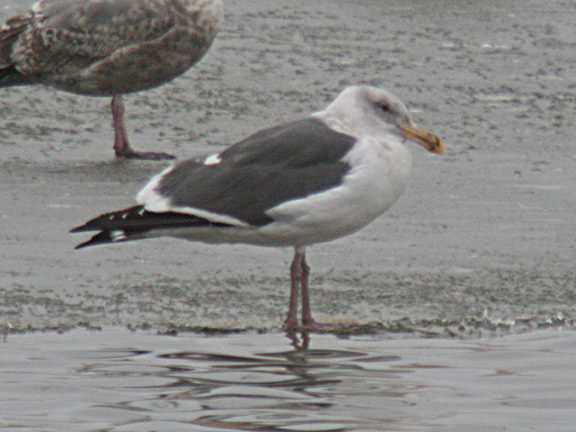 Okay, so let's talk about the birds. The first individual was the first Western Gull to be recorded in Utah. This bird had pretty much developed all adult traits except for having a black tail and some black smudging on the bill. It stuck around till March at which point it was full on into its 4th cycle and lost those traits. The relatively dark mantle along with pink legs and a large bill help with this ID. The large size along with these marks set it off against the flock.
Okay, so let's talk about the birds. The first individual was the first Western Gull to be recorded in Utah. This bird had pretty much developed all adult traits except for having a black tail and some black smudging on the bill. It stuck around till March at which point it was full on into its 4th cycle and lost those traits. The relatively dark mantle along with pink legs and a large bill help with this ID. The large size along with these marks set it off against the flock.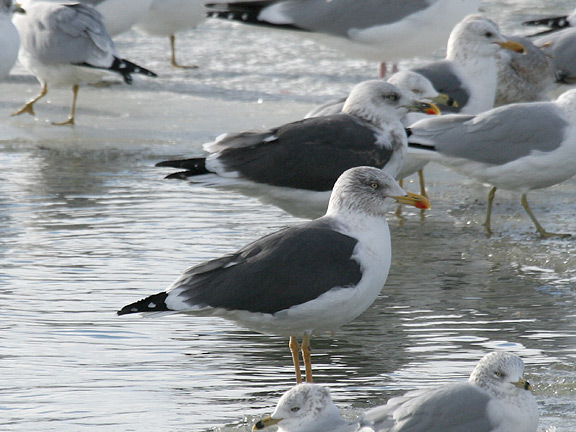 The 2nd birds are pretty straight forward. Very dark backs, yellow eyes, with yellow legs and big yellow bills with red markings. The front bird is an adult, and the one in back is a 3rd winter. Two Lesser Black-backed Gulls photographed together in Utah in the winter would have been unimaginable 15 years ago, now it is sort of expected. These birds are extremely easy to pick out of the masses of lighter mantled birds. Just compare to the other visible gulls in the picture--namely the California and Ring-billed Gulls right behind these two beasts.
The 2nd birds are pretty straight forward. Very dark backs, yellow eyes, with yellow legs and big yellow bills with red markings. The front bird is an adult, and the one in back is a 3rd winter. Two Lesser Black-backed Gulls photographed together in Utah in the winter would have been unimaginable 15 years ago, now it is sort of expected. These birds are extremely easy to pick out of the masses of lighter mantled birds. Just compare to the other visible gulls in the picture--namely the California and Ring-billed Gulls right behind these two beasts.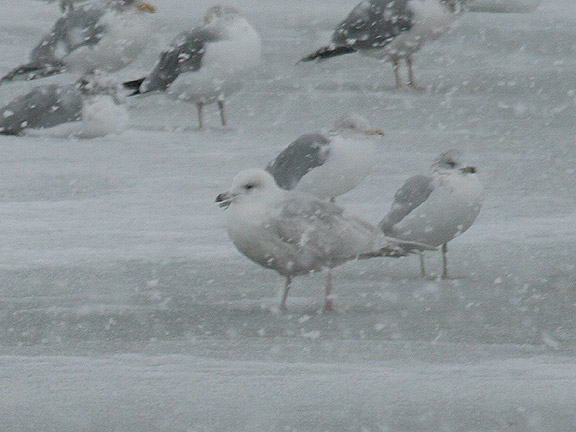 This one could be a curveball for many of us. The diminutive size would seem to eliminate Glaucous Gull, leaving only Iceland Gull as an option. The bi-colored bill along with the dove-shaped head, and light coloration are useful for this ID. In a large flock of gulls, the lack of any dark marking on the bird is helpful in picking it out from the large number of California and Ring-billed Gulls. This species is very rare in Utah in the winter.
This one could be a curveball for many of us. The diminutive size would seem to eliminate Glaucous Gull, leaving only Iceland Gull as an option. The bi-colored bill along with the dove-shaped head, and light coloration are useful for this ID. In a large flock of gulls, the lack of any dark marking on the bird is helpful in picking it out from the large number of California and Ring-billed Gulls. This species is very rare in Utah in the winter.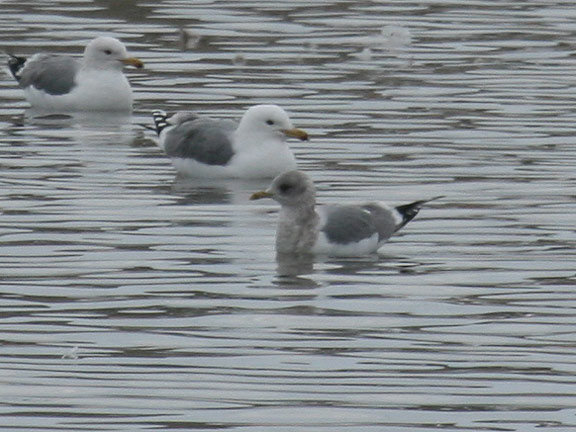 This bird was pretty straightforward. Smaller than the California Gull behind, with smudgy head feathers, and a petite-bill with a faint dark marking--the closest similar bird is a Ring-billed Gull. Picking the Mew out by the head and the bill is often the easiest route. Although reported each year, finding a Mew Gull is always a nice treat.
This bird was pretty straightforward. Smaller than the California Gull behind, with smudgy head feathers, and a petite-bill with a faint dark marking--the closest similar bird is a Ring-billed Gull. Picking the Mew out by the head and the bill is often the easiest route. Although reported each year, finding a Mew Gull is always a nice treat.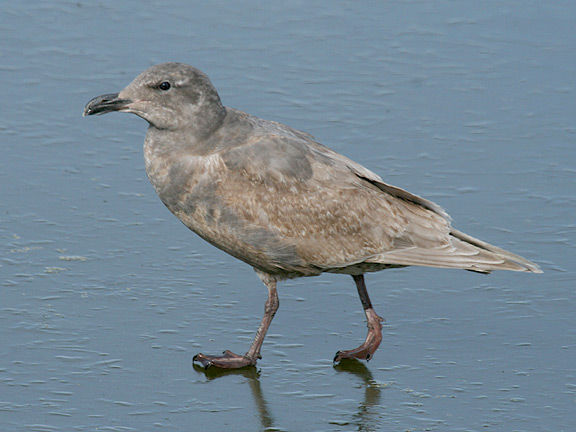 What a hideous beast! The thing that sucks about photos with only one bird is that it is often impossible to gauge the size of the bird. However, for this individual we can tell that it has a relatively large bill in proportion to the body, dirty pink legs, and the gray and smudgy pattern over the entire bird (including primaries that appear lighter than the body) that points to one species—-2nd winter Glaucous-winged Gull. In person you would note the large size which would set the bird off against the tide of smaller gulls. The somewhat plain marking make it stand out against the lighter and darker marking of other species. This species is annual but by no means guaranteed every year.
What a hideous beast! The thing that sucks about photos with only one bird is that it is often impossible to gauge the size of the bird. However, for this individual we can tell that it has a relatively large bill in proportion to the body, dirty pink legs, and the gray and smudgy pattern over the entire bird (including primaries that appear lighter than the body) that points to one species—-2nd winter Glaucous-winged Gull. In person you would note the large size which would set the bird off against the tide of smaller gulls. The somewhat plain marking make it stand out against the lighter and darker marking of other species. This species is annual but by no means guaranteed every year.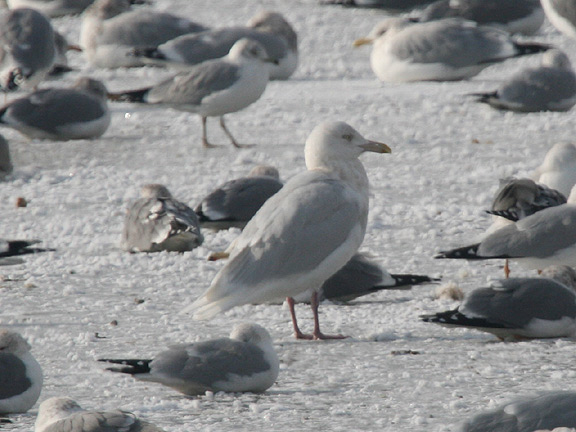 All pale bird, with white primaries and a pale eye that towers over the surrounding gulls. This one is pretty easy, being a Glaucous Gull. The size and pattern make it fairly easy to pick out against the sea of birds with darker markings which is the case in Utah. A handful of individuals are reported each winter for this species in Utah.
All pale bird, with white primaries and a pale eye that towers over the surrounding gulls. This one is pretty easy, being a Glaucous Gull. The size and pattern make it fairly easy to pick out against the sea of birds with darker markings which is the case in Utah. A handful of individuals are reported each winter for this species in Utah. So the angle on bird #7 is a little tough, but a few things stand out. For one it has a nice yellow eye with a visible orange-red orbital ring. It also appears to have a large bill, along with a pale gray mantle, black primaries, and pink feet. All pale winged gulls can be eliminated because of the primaries. California and Ring-billed Gull can be eliminated by leg color (eye color for California as well), leaving the large and 3rd most common Utah winter gull—-the Herring Gull as the answer. This species often blends into the large flocks due to a similar mantle as a Ring-billed Gull, however, the combination of field marks along with its large size help in picking it out. Small numbers over winter each year and can be found at most locations with other flocks of gulls.
So the angle on bird #7 is a little tough, but a few things stand out. For one it has a nice yellow eye with a visible orange-red orbital ring. It also appears to have a large bill, along with a pale gray mantle, black primaries, and pink feet. All pale winged gulls can be eliminated because of the primaries. California and Ring-billed Gull can be eliminated by leg color (eye color for California as well), leaving the large and 3rd most common Utah winter gull—-the Herring Gull as the answer. This species often blends into the large flocks due to a similar mantle as a Ring-billed Gull, however, the combination of field marks along with its large size help in picking it out. Small numbers over winter each year and can be found at most locations with other flocks of gulls.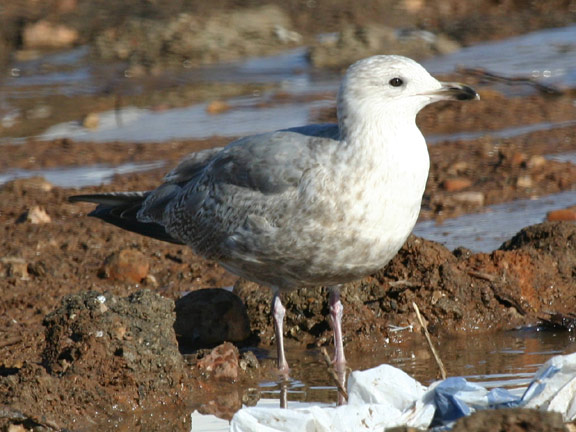 #8 is probably one of the toughest in this grouping, mainly because its wings are partially hidden. What we can see is that it has pink legs, a dark eye, a bill that is sort of pinkish fading into a dark tip, a light gray back, and clean, lightly patterned coverts. Nothing really helps with size, but we can say the bill isn't overly large in relation to the size of the bird. The bird isn't an adult—which is why learning all the 3 and 4 cycle gull plumages and patterns is helpful. To start eliminating, let's start with the most common birds, like California Gull which at this point would have either a completely bi-colored pink bill with black tip, or a bill that is starting to turn yellow-gray. The bill is again wrong for a Ring-billed Gull. Herring Gull would also have a bi-colored bill at this point. Although we can't see the wing tips all that well, they don't appear overly pale, eliminating Glaucous, and Glaucous-winged. If you look closely you can see pale edging on the tip of each primary, and if you look at the left wing (you can only see the inside of P10, it looks to be brownish instead of blackish. If you were to flip open a field guide to Thayer's Gull, you would see a pretty good depiction of a 2nd winter bird that looks just like this—BINGO! I have only ever seen 2 second winter THGU in Utah in the winter, making them pretty rare. Most individuals we see are 1st winter birds and adults. Knowing the oddballs can help in IDing them and eliminating other species as well. In terms of picking this guy out of a flock, it would be a little larger than most of the gulls present, and the primaries would be lighter than most of the dark winged gulls, and darker than all of the white-winged gulls.
#8 is probably one of the toughest in this grouping, mainly because its wings are partially hidden. What we can see is that it has pink legs, a dark eye, a bill that is sort of pinkish fading into a dark tip, a light gray back, and clean, lightly patterned coverts. Nothing really helps with size, but we can say the bill isn't overly large in relation to the size of the bird. The bird isn't an adult—which is why learning all the 3 and 4 cycle gull plumages and patterns is helpful. To start eliminating, let's start with the most common birds, like California Gull which at this point would have either a completely bi-colored pink bill with black tip, or a bill that is starting to turn yellow-gray. The bill is again wrong for a Ring-billed Gull. Herring Gull would also have a bi-colored bill at this point. Although we can't see the wing tips all that well, they don't appear overly pale, eliminating Glaucous, and Glaucous-winged. If you look closely you can see pale edging on the tip of each primary, and if you look at the left wing (you can only see the inside of P10, it looks to be brownish instead of blackish. If you were to flip open a field guide to Thayer's Gull, you would see a pretty good depiction of a 2nd winter bird that looks just like this—BINGO! I have only ever seen 2 second winter THGU in Utah in the winter, making them pretty rare. Most individuals we see are 1st winter birds and adults. Knowing the oddballs can help in IDing them and eliminating other species as well. In terms of picking this guy out of a flock, it would be a little larger than most of the gulls present, and the primaries would be lighter than most of the dark winged gulls, and darker than all of the white-winged gulls.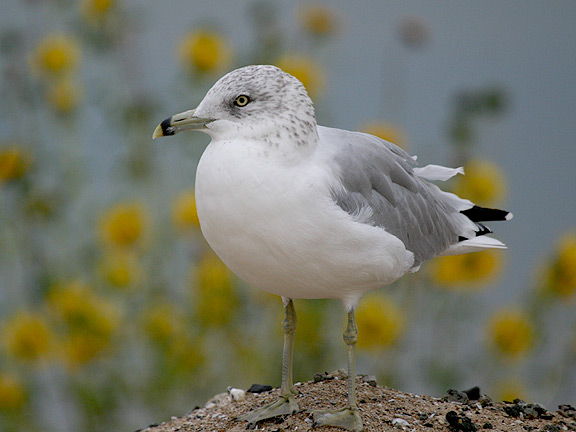 #9 is pretty easy. Yellow eyes, yellow legs, and a yellow ringed-bill. That would be a Ring-billed Gull. No other species really fits this bird, and being the most common/widespread small dark-winged gull in America makes it easily recognizable. It also is one of the standards to use for picking out other gulls. In Utah I am always looking for birds that are larger, with lighter or darker mantles than California and Ring-billed to find other gulls. It is a good starting point when looking at a flock of 2000 gulls.
#9 is pretty easy. Yellow eyes, yellow legs, and a yellow ringed-bill. That would be a Ring-billed Gull. No other species really fits this bird, and being the most common/widespread small dark-winged gull in America makes it easily recognizable. It also is one of the standards to use for picking out other gulls. In Utah I am always looking for birds that are larger, with lighter or darker mantles than California and Ring-billed to find other gulls. It is a good starting point when looking at a flock of 2000 gulls.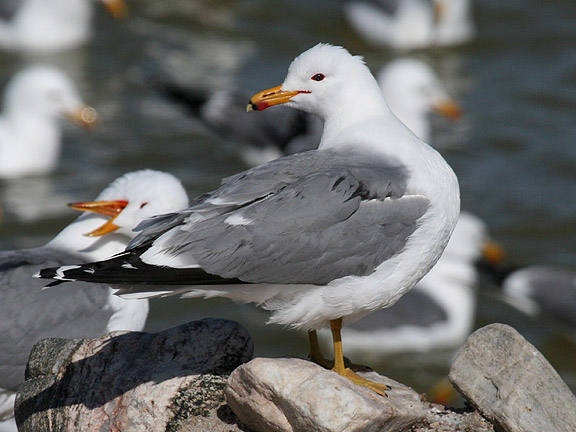 #10 isn't really fair as the bird isn't in winter plumage. However, being the Utah state bird makes it a pretty easy pick for Utah birders. The orange-yellow bill, with red and black spot, dark eye, medium dark mantle and dirty yellow legs are a common sight at most parks, and parking lots around the Great Salt Lake. Knowing all the cycles of California Gulls will help in identifying other gulls in the large flocks we scan for other gulls. After doing it for a while, you can easily pick over gulls without having to take a second look at the California's.
#10 isn't really fair as the bird isn't in winter plumage. However, being the Utah state bird makes it a pretty easy pick for Utah birders. The orange-yellow bill, with red and black spot, dark eye, medium dark mantle and dirty yellow legs are a common sight at most parks, and parking lots around the Great Salt Lake. Knowing all the cycles of California Gulls will help in identifying other gulls in the large flocks we scan for other gulls. After doing it for a while, you can easily pick over gulls without having to take a second look at the California's.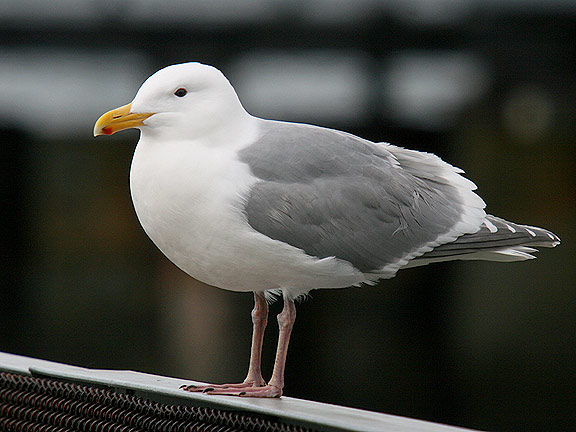 #11 is a common sight across the Pacific Northwest. It seems to have a darker mantle like a Western Gull—but not too dark, and paler primaries like a Glaucous-winged Gull—but not too pale. It is sort of the epitome of mass hybridization. Many call it the "Olympic" Gull, named after the Olympic Peninsula where it can be readily studied—however, the rest of us call it a Hybrid, the Western X Glaucous-winged Gull. I don't have a whole lot of ID tips for this species, as it is not a species, and instead a highly variable and often confusing hybrid. I have looked at a flock of 25 of these buggers with each one displaying different characteristics than the next. If you see a gull that looks somewhat Western like, and somewhat Glaucous-winged like, it's a pretty good bet you have a hybrid, and we occasionally see them in Utah in the winter.
#11 is a common sight across the Pacific Northwest. It seems to have a darker mantle like a Western Gull—but not too dark, and paler primaries like a Glaucous-winged Gull—but not too pale. It is sort of the epitome of mass hybridization. Many call it the "Olympic" Gull, named after the Olympic Peninsula where it can be readily studied—however, the rest of us call it a Hybrid, the Western X Glaucous-winged Gull. I don't have a whole lot of ID tips for this species, as it is not a species, and instead a highly variable and often confusing hybrid. I have looked at a flock of 25 of these buggers with each one displaying different characteristics than the next. If you see a gull that looks somewhat Western like, and somewhat Glaucous-winged like, it's a pretty good bet you have a hybrid, and we occasionally see them in Utah in the winter.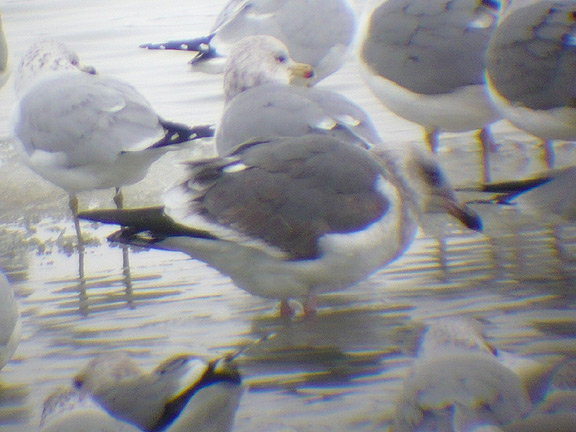 Last but not least in my book is a bird that will bother me for the rest of my life. This two day wonder showed up the week after Christmas in 2007. It looked unlike any gull I had ever seen, and seemed to fit one bird that I had always had high hopes of finding in Utah. The bird was large, with a very dark back, a mixed pink and black bill, and a pale but not yellow or brown eye. It resembles a Western Gull which is what some think it might be, it also however resembles an advanced 2nd winter or 3rd winter Slaty-backed Gull—meaning it has several characteristics of a 2nd winter Slaty-backed (like a black tail and the mixed bill), and other characteristics of a 3rd winter bird like the mantle and wings. The issue I had with Western Gull was the "fierce" look of the face, along with the pale eye. Upon reviewing several books I found plenty of pictures that resembled the bird in question (including this individual). In any event, I sent the pictures to a the ID Frontiers list, and as with almost everything I have ever posted there it is a 50/50 split on what people thought, and in the end left me not particularly caring to use the list any longer.
Last but not least in my book is a bird that will bother me for the rest of my life. This two day wonder showed up the week after Christmas in 2007. It looked unlike any gull I had ever seen, and seemed to fit one bird that I had always had high hopes of finding in Utah. The bird was large, with a very dark back, a mixed pink and black bill, and a pale but not yellow or brown eye. It resembles a Western Gull which is what some think it might be, it also however resembles an advanced 2nd winter or 3rd winter Slaty-backed Gull—meaning it has several characteristics of a 2nd winter Slaty-backed (like a black tail and the mixed bill), and other characteristics of a 3rd winter bird like the mantle and wings. The issue I had with Western Gull was the "fierce" look of the face, along with the pale eye. Upon reviewing several books I found plenty of pictures that resembled the bird in question (including this individual). In any event, I sent the pictures to a the ID Frontiers list, and as with almost everything I have ever posted there it is a 50/50 split on what people thought, and in the end left me not particularly caring to use the list any longer.The point of this last gull was that every year we encounter several gulls that we just can't put a positive ID to, or even safely ID in some cases—and even with trying to reach out for help sometimes you are going to get mixed results.
With gulls there are so many hybridizations, and so many strange patterned birds, that it makes for not only fun ID challenges but also some quite frustrating moments. This wasn't a scientific look at how to identify gulls, and didn't cover anything outside of the pictures that were shown. If you really want to get into gulling you need to pick up a gull specific field guide, like Peterson's, and you have to have a spotting scope, especially to scan through large flocks that are sitting on frozen lakes. Most of all you need to be patient, and just keep on looking—with more time in the field identifying gulls becomes easier, and finding rare gulls becomes not a thing of luck, but of hard work persistence.
Labels: gulls, id challenge, identification
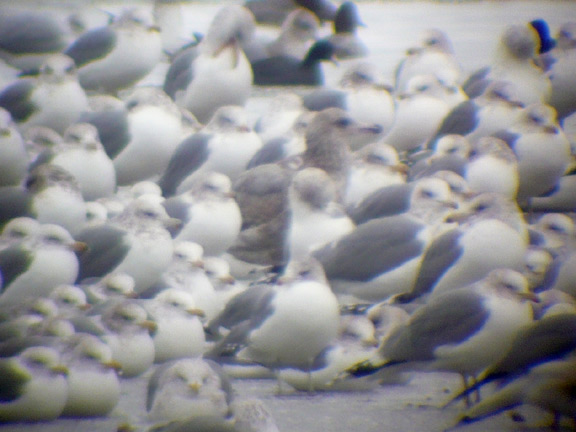


4 Comments:
Wow! That was informational and surprising. I am not a huge "guller" but this information will be useful if I make it out to look at any this winter.
High praise for tackling gulls with such clarity
Jerry
Thank you Jerry. There is so much more to cover on this family, so hopefully I can put together a few good posts.
Recording success in Cryptocurrency, Bitcoin is not just buying and holding till when bitcoin sky-rocks, this has been longed abolished by intelligent traders ,mostly now that bitcoin bull is still controlling the market after successfully defended the $60,000 support level once again and this is likely to trigger a possible move towards $100,000 resistance area However , it's is best advice you find a working strategy by hub/daily signals that works well in other to accumulate and grow a very strong portfolio ahead. I have been trading with Mr Bernie doran daily signals and strategy, on his platform, and his guidance makes trading less stressful and more profit despite the recent fluctuations. I was able to easily increase my portfolio in just 1week of trading with his daily signals, growing my $3000 to $25,000 Mr Bernie’s daily signals are very accurate and yields a great positive return on investment. I really enjoy trading with him and I'm still trading with him, He is available to give assistance to anyone who love crypto trading and beginners in bitcoin investment ,he can also help you recover your lost funds I would suggest you contact him on WhatsApp : + 1424(285)-0682 , Gmail : (BERNIEDORANSIGNALS@GMAIL.COM) or Telegram : @IEBINARYFX for inquiries
Post a Comment
Subscribe to Post Comments [Atom]
<< Back to Previous